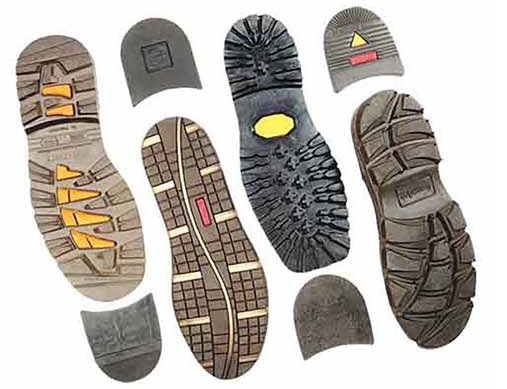Each shoe consists of two parts: cumin and faceted. In this article, we want to introduce a variety of cumin shoes and examine the different materials used in it.The articles you will read in this article. Features of cumin footwear Materials used in the manufacture of cumin footwear (natural rubber – synthetic rubber) Shoemaker Shoe Styrene Butadiene Rubber (SBR) Nitrile rubber footwear footwear (NBR) Neoprene Chloropyrine (CR) footwear footwear Crimping Thermoplastic Elastomer (TPE)When shopping for shoes, footwear is one of the things that should be considered. The features we would expect from a cumin footwear include:Appearance and Beauty: The first option in the shoes is the appearance that it is apparent on the appearance of the products and increases the power of choice in the buyers.Impact Absorber: A cumin foot should be absorbed by the pressure and the impact of the legs.Resistant to erosion: Cumin shoes, due to their use, should have high resistance to erosion. A tennis player, for example, tends to use a cowhide with a high resistance to abrasion.Resistance to bending: Walking and running cumin exposed the shoes to bend. Cumin shoes with high resistance to bending are easily bent and not damaged. Customers expect their footwear to not be easily damaged during exercise and walking and in extreme temperatures and environments.Slip resistance: In other words, the amount of friction or coefficient of friction between the materials of different types of cumin shoes and the various materials of the flooring should be high to prevent slipping and damage to the person.Special shoes for use in certain places and occupations, such as safety shoes, should have the maximum protection from the workers’ foot. Depending on the working environment and conditions, the cumin shoes should have a good return. For example it should be resistant to solvent, oil, petroleum, hydrolysis, static electricity and abrasion resistance. Antistatic agents, antibacterials, etc., which add to the shampoo polymer, improve their properties and resistance.Materials used in the production of footwearCumin footwear can be natural or artificial, which can be changed based on the use of shoes in specific places or customer orders. It should be noted that each of these materials, according to their physical characteristics, is used to produce shoes with different characteristics.TiresThe features of the rubber footwear types include:1. High durability2. Flexibility3. Waterproof4. Easier and cheaper than leather productionNatural rubber (NR)The outstanding elasticity and outstanding natural rubber properties of all types of footwear allow you to remain soft and flexible in cold weather. Resistance to rupture, perforation and slippage of natural rubber is higher than that of cumin. Natural rubber is resistant to chemicals such as bases, acids, alcohols and water-based solutions. Cold Resistance (Soft and Flexible) High resistance to tear, perforation, slip High resistance to water-based solutionsThe disadvantages of natural rubber are that, because natural rubber is a hydrocarbon, it does not withstand long contact with petroleum solvents and gasoline.NR safety footwear is used in food, transportation, facilities, buildings and agriculture.Synthetic rubberNowadays, the raw materials of production of most types of shoes with rubber cuffs are of synthetic type to the natural rubber cushion that was obtained from the trees in the past. Cumin shoes made from rubber are usually a combination of several rubber additives to control the physical properties of the cumin shoes. Some black compounds may cause foaming (depending on the type of carbon black used). Cumin shoes are used in a variety of shoes such as industrial shoes to shoe covers.Shoemaker Shoe Styrene Butadiene Rubber (SBR) Styrene-butadiene rubber is the cheapest and most commonly used synthetic rubber in the shoe market, whose price and resistance to abrasion are considered to be the benefits of this rubber. But there are some disadvantages, including the low resistance of this type of rubber to fatigue. .Nitrile rubber footwear footwear (NBR)NBR cumin or nitrile copolymer elastomer, which forms a mixture of butadiene and acrylonitrile. And is mainly used for areas requiring high resistance to oil and oil shoots. NBR rootstock has a high resistance to minerals and vegetable oils, but has a low resistance to oxidized solvents such as acetone, methyl ethyl ketone and other ketones. NBR rootstock has high resistance to acids and bases. Resistance to heat loss compared to natural rubber is an advantage to the NBR substrate. By increasing the acrylonitrile content in the NBR substrate, the resistance to solvents increases, but the flexibility decreases at its low temperature. At low temperature, the flexibility of NBR is lower than normal rubber. Although the flexibility of the low-temperature NBR can be improved by adding compounds, the advantages and disadvantages of the NBR substrate can be attributed to its resistance to oil and solvents. In most cases, resistance to oil, gasoline and aromatic hydrocarbons is used instead of the natural rubber footwear of NBR rubber.Benefits of footwear NBR:1. High Resistance to Oil Solution2. Upper resistance against minerals and vegetable oils3. High resistance
Familiarize with all types of footwear (Part I)

23
فروردین